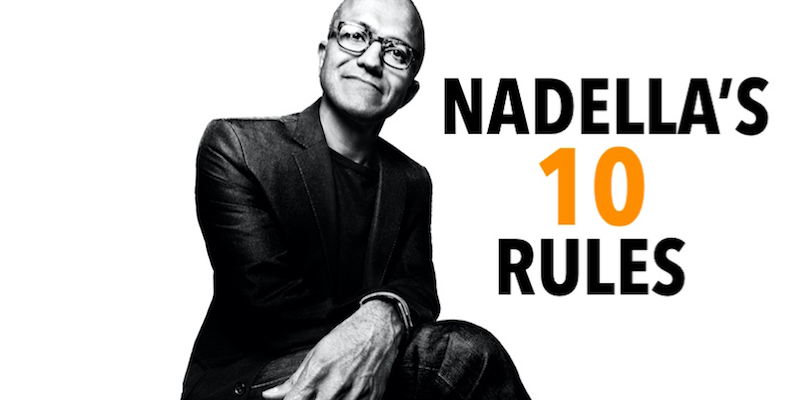Satya Nadella, since being appointed CEO of Microsoft in February 2014, has launched Windows 10, a move that positions Microsoft as a platform-centric company, allowing users to experience OS services across devices. Nadella has said that he plans to make Windows services platform neutral.
Before becoming CEO of Microsoft, he was Executive Vice President of Microsoft’s Cloud and Enterprise group. Satya was born into a Telugu speaking family in Hyderabad, India.
He attended the Hyderabad Public School and attained a bachelor’s degree in electrical engineering from the Manipal Institute of Technology. He subsequently traveled to the U.S. to study for an M.S. degree in Computer Science.

Here are the 10 success lessons from Satya Nadella – “Microsoft Boss” for entrepreneurs,
1. Continuously re-invent yourself
When Satya Nadella joined Microsoft in 1992, no one had visioned cloud computing. In his own words a couple of months ago, he says ” …it was all about business process automation and communication driving productivity in the previous generation.
The key trends emerging now are software defined data centers, application platforms, storage, and big data. Ten years down the line, he envisions the most innovative work happening around the conversion of data into meaningful insights and actions.”
2. Know when your team needs a confidence boost
The CEO says he received one of his earliest leadership lessons during a school cricket match. He wasn’t playing his best, so the team captain took his place for a while until their team started faring better.
Nadella then was put back in to finish the match. “I never asked him why he did that, but my impression is that he knew he would destroy my confidence if he didn’t put me back in,” Nadella says. “And I went on to take a lot more wickets after that.
It was a subtle, important leadership lesson about when to intervene and when to build the confidence of the team. I think that is perhaps the No. 1 thing that leaders have to do: to bolster the confidence of the people you’re leading.”
3. Be open about your plans
In 2008, when Satya Nadella was appointed to head the Microsoft’s search, portal and advertising platform group, he was perceived as a greenhorn, even though he was with the company for 15 years! Nadella sent out a memo to employees laying out objectives for the year that gave analysts a glimpse into his plans.
His goals outlined in the note included developing a strong “destination search experience,” reinventing the MSN portal, scaling the company’s ad platform and emphasising innovation and agility at the group.
4. Get your basics right
Mary Jo Foley, a journalist and blogger at ZDNet says “I was impressed by how technical Satya was, all about Microsoft. He can go really deep technically as much as any programmer”.
This suggests that to excel at the top, you need to have a solid grounding in your field of work. Getting the basics of your field of study right, should be first and foremost in any engineering students quest for fame.
5. Stay focused on the cards you’ve been dealt
Nadella tells the Times that during a performance review one year, he asked former CEO Steve Ballmer how he (Nadella) compared to his predecessors. Ballmer’s answer was, “‘Who cares? The context is so different.
The only thing that matters to me is what you do with the cards you’ve been dealt now,’” Nadella recounts. “‘I want you to stay focused on that, versus trying to do this comparative benchmark.’” Although Nadella wanted a straight answer, he tells the Times that Ballmer’s response impressed a larger point on him: “The lesson was that you have to stay grounded, and to be brutally honest with yourself on where you stand.”
6. Innovation trumps institutional structures
Nadella has a mandate to effect a change in culture at Microsoft. But what is the right mindset to try to develop throughout an organization that employs more than 100,000 people? Nadella says the top priority should be “recognising innovation and fostering its growth.”
Making that happen is “not going to come because of an org chart or the organizational boundaries,” he says. “Most people have a very strong sense of organizational ownership, but I think what people have to own is an innovation agenda, and everything is shared in terms of the implementation.”
7. If you want to sell an idea, product or service, put yourself in the other person’s shoes
A well known fact about Satya Nadella is that he has a Master’s degree in Management in addition to his Masters in engineering. This gives him insight into the workings of consumer behaviour and helps him take decisions that will be appreciated by the end-users.
The key lesson learnt here is to always know whether what you are planning will be appreciated by the person who uses your stuff in the end. That’s empathy. That’s seeing the world not as it is but as it should be. It’s started from that first touch the user has with a product and says “ahh” to the beginning and building what is needed which may look nothing like what exists today.
8. There is no “Me” in Team
Any big organization is just one bad leader away from becoming a stultifying bureaucracy. Nadella came down firmly in favour of a culture driven by individual initiative: “Every one of us needs to do our best work, lead and help drive cultural change.
We sometimes underestimate what we each can do to make things happen and overestimate what others need to do to move us forward. We must change this.”
9. Know about your competitors, but focus on your strengths
In his current job in the Servers and Tools business at Microsoft, Satya Nadella focuses on improving both Windows Azure and Office 365. But he does keep a track of what Google and Amazon are doing with their systems.
In his own words “If you look at Amazon or Google, the two other providers in the cloud, we have a very unique way to tell a customer that it is not just about building an application in the Azure platform but [also] having a way to take it out or to extend it.”
The lesson which you can take from this is to always stay focused on your strengths, but, do not discount your competition. Learn a few things from your competitors as well and try to improve upon that.
10. Be Analytic
Nadella’s ideas didn’t just spark out of nowhere the moment he became CEO. Before being promoted, he had a very successful run as the head of Cloud and Enterprise, making Microsoft the second largest player in the cloud space essentially by applying the same “mobile-first, cloud-first” strategy he’s now bringing to all of Microsoft.
Azure, the company’s cloud business, made inroads into its market by offering products and services from all over the technology landscape, instead of being limited to a Windows-centric technology stack.
Clearly, the large transformation taking place at Microsoft is not the result of a series of reactions to emergencies, but of long and well-honed reflections on the state of the market, the industry and the company.



